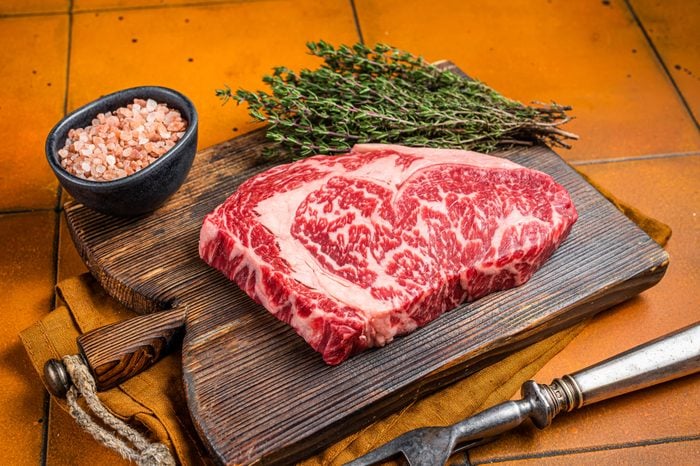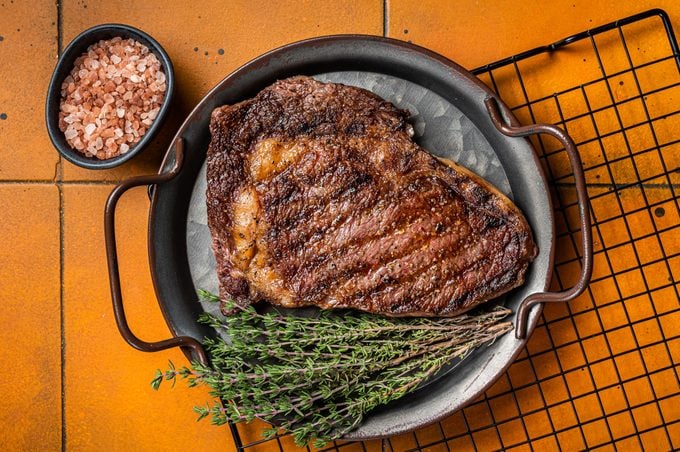What Is Wagyu Beef—And Is It Worth Ordering?
Updated: Dec. 19, 2023

Why is wagyu beef so expensive at a steakhouse, and is it even worth it? Is your money better spent elsewhere?
You don’t need a six-figure salary to visit a steakhouse—unless you’re looking at the wagyu beef section. The price of wagyu steaks is enough to take your breath away. The smallest wagyu steak costs more than the largest filet mignon (the most expensive regular steak on the menu). On average, wagyu beef can run more than $200 per pound (that’s $12.50 per ounce!), so what gives? Why is wagyu beef so expensive, and is this uber-expensive steak truly worth it?
What is wagyu beef?
The word wagyu has a pretty literal translation: “wa” means Japanese, and “gyu” is cow. But that doesn’t mean that any Japanese cow qualifies. Wagyu beef breeds are carefully selected, and genetic testing is used to ensure only the best are allowed into the program. By paying so much attention to genetics, the beef becomes genetically predisposed to have a higher quality than most steaks. This tender, well-marbled beef really does taste better than the competition.
In Japan, only four types of cattle are used: Japanese Black, Japanese Brown, Japanese Polled and Japanese Shorthorn. American wagyu programs primarily use Japanese Black, although there are a few Japanese Brown in the mix (known as Red Wagyu in the States).
Why is wagyu beef so expensive?
In 1997, Japan declared wagyu a national treasure and banned any further exportation of cattle, which means they largely control the market on wagyu beef. American ranchers are working hard to increase the production of this sought-after beef, but only 221 animals were exported to the United States before the ban was in place. That’s a small pool considering that Japan uses progeny testing to ensure only the best genetics are kept for breeding.
The other thing that keeps wagyu so expensive is Japan’s strict grading system for beef. The United States Department of Agriculture (USDA) classifies beef as Prime, Choice, Select or a lower grade. The Japanese Meat Grading Association (JMGA) goes into way more depth with wagyu, grading the beef’s yield and ranking quality based on fat marbling, color, brightness, firmness, texture and quality of fat. The highest grade is A5, but the fat quality scores are crucially important. These scores range from 1 to 12, and by JMGA standards, USDA prime beef would only achieve a fat quality score of four.
How is wagyu beef raised?
Wagyu cattle are chosen in a highly selective process. They are raised by a breeder until they reach almost a year old and are sold, for a hefty price, to a farmer. Many take to a strict grain diet to encourage marbling.
Joseph Decuis in Roanoke, IN is the only restaurant in the United States raising Wagyu with traditional Japanese husbandry practices. The beef is all natural, raised humanely and drug free. They verify pedigree through DNA testing and even play music to the cattle to ensure a happy environment.
How do you cook wagyu beef?

Because the quality of the beef is so high, it’s best to stick with a simple cooking method. The best way to cook wagyu is to first sprinkle the beef with a little salt and pepper. Then, sear it in a cast-iron pan over high heat for three to four minutes.
Is wagyu beef worth it?
There are plenty of tricks to get cheap meat to taste great, so why drop so much coin on wagyu? For starters, it literally melts in your mouth. The fat in wagyu beef melts at a lower temperature than most beef, which gives it a buttery, ultra-rich flavor. All that fat also makes the beef juicier than a regular steak, and since it contains more fatty acids, it also has a more appealing aroma.
Wagyu beef is best consumed in smaller, three- or four-ounce portions; a huge steak would overload your taste buds. Considering its high price tag, you want to appreciate every bite!
Wagyu is also great in yakitori-style beef skewers, or traditional Japanese dishes like shabu-shabu or sukiyaki that feature thinly sliced beef. These dishes will let you enjoy the flavor of this high-quality beef in smaller quantities (without breaking the bank, too).
While an incredible piece of meat, it’s not practical to enjoy wagyu regularly. For most people, it’s a once in a lifetime experience. To make the most out of your typical steakhouse experience, order a steak that you can’t find at the local butcher shop (like dry-aged steaks). Or go all-in for a tomahawk steak or something that you might not normally cook.

